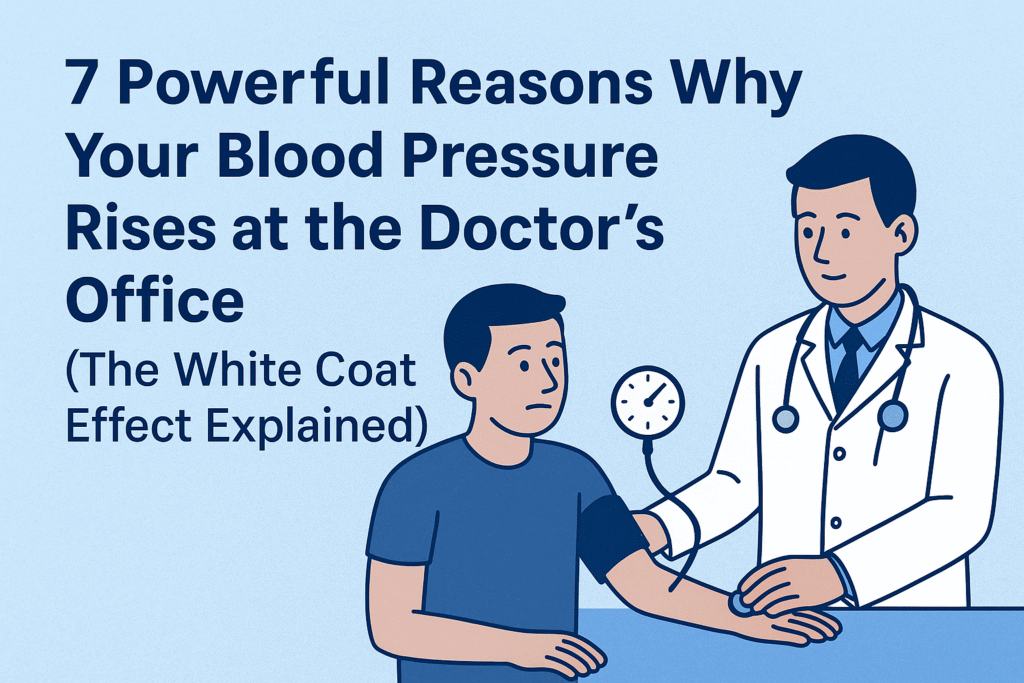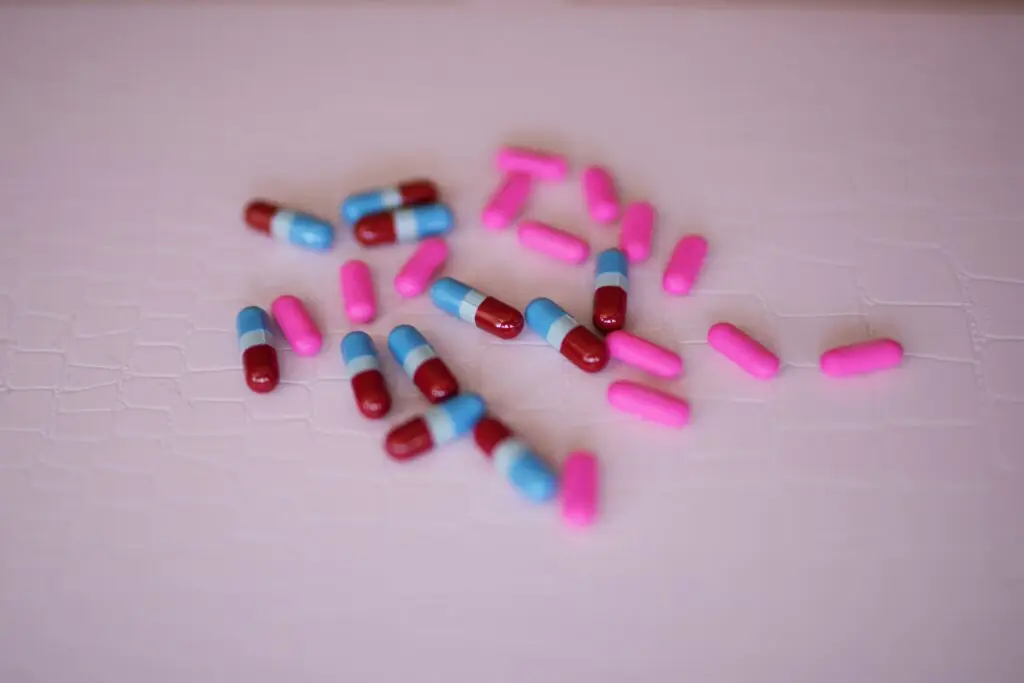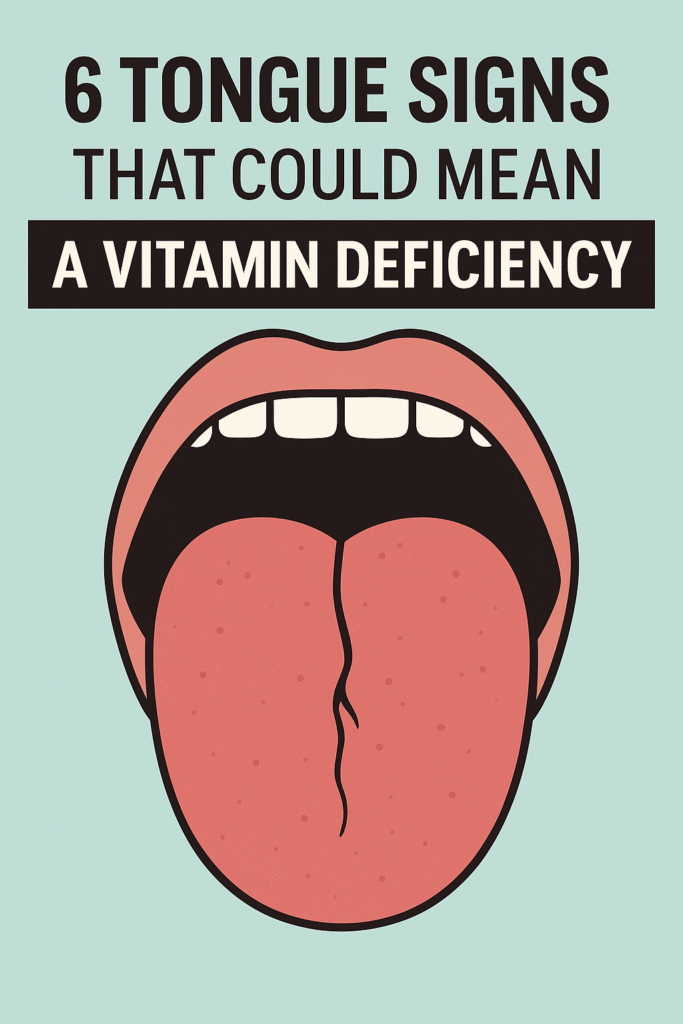
⚠️ Affiliate Disclaimer: This post may contain affiliate links, which means I may earn a small commission — at no extra cost to you — if you make a purchase through one of these links. I only recommend products or services I genuinely trust and believe can provide value. Thank you for supporting My Medical Muse!
7 Powerful Reasons Why Your Blood Pressure Rises at the Doctor’s Office
Most people have experienced this, your doctor wraps the blood pressure cuff around your arm, starts pumping, and suddenly the numbers are higher than usual. Yet when you check your blood pressure at home, it’s completely normal. That frustrating spike in your reading isn’t your imagination, it’s called the White Coat Effect (or White Coat Hypertension), and it’s a surprisingly common phenomenon that can influence your health diagnosis and treatment decisions.
In this in-depth guide, we’ll explore:
What the white coat effect is
Why it happens, psychologically and physiologically
Who’s most likely to experience it
How it can affect your health over time
Practical ways to manage or prevent it
What Is the White Coat Effect?
The white coat effect refers to a temporary rise in your blood pressure that occurs when it’s measured in a medical or clinical setting, often in front of a doctor or nurse wearing a white coat (hence the name). It doesn’t necessarily mean you have high blood pressure in everyday life. Instead, your blood pressure spikes only during that clinical encounter, often due to anxiety, anticipation, or stress associated with being examined.
Types of White Coat Hypertension
There are two related but distinct terms you’ll often hear:
- White Coat Hypertension (WCH): Your blood pressure is elevated in the doctor’s office but normal when measured outside the clinic (for example, at home or with a 24-hour monitor).
- White Coat Effect: Even if you already have hypertension, your readings are significantly higher at the doctor’s office compared to your usual levels.
How Common Is It?
Studies show that:
- 15-30% of people with high readings in clinics actually have white coat hypertension.
- It’s more frequent in women, older adults, and non-smokers.
- It’s especially common during first-time visits or when patients meet a new healthcare provider.
What Happens in Your Body During the White Coat Effect?
Your blood pressure isn’t just a mechanical number, it reflects how your body and mind react to your environment. When you walk into a clinic, your body subconsciously perceives it as a high-stakes situation, maybe you’re worried about getting bad news, feeling judged, or anxious about the test itself. These emotions trigger your body’s “fight-or-flight” response.
The Stress Response Explained
Here’s what happens step by step:
- Perceived Stress: You feel anxious or tense in the clinical environment.
- Hormone Surge: Your brain signals the adrenal glands to release adrenaline and cortisol.
- Physiological Reaction:
- Heart rate increases
- Blood vessels constrict
- Cardiac output rises
- Heart rate increases
- Result: Your systolic (top number) and diastolic (bottom number) blood pressures both increase temporarily.
Even mild anxiety can raise systolic blood pressure by 10 to 30 mmHg, sometimes more if you’re especially nervous.
Why It’s Called the “White Coat” Effect
In early medical studies, researchers noticed that blood pressure readings tended to rise specifically when doctors, often wearing white coats, measured them, compared to readings taken by nurses or automated machines. Over time, it became clear that the presence of a doctor’s authority and the clinical environment both play key roles in triggering this effect.
Psychological Triggers: Why Your Mind Influences the Numbers
The white coat effect is a fascinating example of how psychology can affect physiology. Let’s explore the common psychological factors behind it:
a. Anxiety or Fear of Bad Results:
Many people unconsciously worry that a high reading will mean “something’s wrong.” This fear alone can make the blood pressure go up, a self-fulfilling prophecy.
b. Performance Pressure:
Just like “test anxiety” during exams, some patients feel a pressure to “perform well” during check-ups. Ironically, the desire to appear healthy can cause tension that pushes readings higher.
c. Previous Negative Experiences:
If you’ve ever received bad news at a doctor’s office or had a painful or stressful experience, your brain associates the setting with discomfort. Even subtle cues (like the smell of disinfectant or the sound of medical equipment) can trigger stress memories.
d. Lack of Familiarity:
When the doctor or nurse is unfamiliar, your body might perceive the situation as slightly threatening. Repeated visits with the same provider often reduce this effect over time.
Who Is Most Likely to Experience the White Coat Effect?
Not everyone experiences a blood pressure surge at the doctor’s office. Certain groups, however, are more prone:
Risk Factor | Why It Matters |
Older adults | Increased cardiovascular sensitivity and anxiety about results |
Women | May be more sensitive to social and emotional stressors |
People new to clinical settings | Higher anxiety during first visits |
Those with generalized anxiety | More likely to activate the stress response easily |
People who rarely monitor BP at home | Unfamiliarity with the process leads to tension |
Interestingly, even health-conscious individuals are not immune. People who regularly check their blood pressure and are aware of hypertension risks can become overly focused on the readings themselves, which ironically increases stress and spikes their BP temporarily.
Is White Coat Hypertension Dangerous?
At first glance, white coat hypertension seems harmless, after all, your blood pressure is normal at home, but recent studies show it deserves attention.
Short-Term vs. Long-Term Risks
- Short-Term: The immediate spikes during office visits are temporary and typically resolve once you leave.
- Long-Term: Repeated surges can stress your blood vessels over time and might increase your risk of developing true hypertension later in life.
Key Research Findings
- A 2019 meta-analysis published in Hypertension found that people with white coat hypertension have a 38% higher risk of developing sustained hypertension within 10 years compared to those with normal readings.
- The same study noted a 20-30% higher risk of heart disease or stroke in older adults with untreated white coat hypertension.
So, while it’s not immediately dangerous, it’s a warning signal that your cardiovascular system is sensitive to stress and that managing anxiety and monitoring your BP regularly is crucial.
How Doctors Diagnose White Coat Hypertension
To distinguish white coat hypertension from true high blood pressure, doctors rely on out-of-office monitoring methods.
a. Home Blood Pressure Monitoring
You use an accurate digital monitor to check your BP at home, usually twice a day (morning and evening), for several days. These readings are then compared with clinic results.
- Normal home BP: Below 135/85 mmHg
- Clinic threshold for hypertension: Above 140/90 mmHg
If your home readings are consistently lower than clinic ones, it suggests white coat hypertension.
b. Ambulatory Blood Pressure Monitoring
This is the gold standard for diagnosis. You wear a small monitor that measures your blood pressure automatically every 15-30 minutes over 24 hours, even while sleeping.
ABPM gives doctors a detailed picture of your blood pressure trends, identifying:
- White coat hypertension (high in clinic, normal elsewhere)
- Masked hypertension (normal in clinic, high elsewhere)
- True sustained hypertension (high everywhere)
The White Coat Effect vs. Masked Hypertension
It’s important not to confuse white coat hypertension with its opposite, masked hypertension.
Condition | Office BP | Home BP | Common Scenario |
White Coat Hypertension | High | Normal | Nervous at the clinic |
Masked Hypertension | Normal | High | Stressed at work or poor sleep at home |
Masked hypertension can be more dangerous because it goes unnoticed, highlighting why consistent home or ambulatory monitoring is vital.
How White Coat Effect Can Affect Your Medical Care
a. Misdiagnosis or Overtreatment
If your doctor only relies on office readings, you might be wrongly diagnosed with hypertension and prescribed unnecessary medication.
b. Undue Anxiety
Being told you have high blood pressure, even temporarily can make you more anxious about future visits, creating a vicious cycle where anxiety keeps raising your readings.
c. Hidden Progression
Some people with white coat hypertension eventually develop sustained hypertension. Without proper follow-up, this transition might be missed until complications arise.
d. Skewed Clinical Data
For those already on medication, the white coat effect can make it seem as though the treatment isn’t working, leading to unnecessary dosage increases.
Practical Ways to Reduce the White Coat Effect
You can take several steps to make your readings more accurate and reduce anxiety before and during check-ups.
1. Practice Relaxation Before the Appointment:
- Arrive early to avoid rushing.
- Sit quietly for at least 5 minutes before the test.
- Try deep breathing or slow exhalations, inhaling for 4 seconds, exhaling for 6.
- Avoid caffeine, smoking, or exercise 30 minutes before your appointment.
2. Request a Rest Period:
Ask your nurse or doctor to give you a few minutes of rest before taking your reading or take multiple readings and average them. Blood pressure often drops after the first measurement.
3. Use Self-Measurement or Automated Devices:
If possible, use a self-service blood pressure kiosk or bring your own home monitor to compare results. Readings taken by yourself, or by a nurse rather than a doctor, are often lower.
4. Build Familiarity With the Environment:
Regular visits and positive interactions with your healthcare provider can gradually desensitize your anxiety response.
5. Keep a Blood Pressure Log:
Maintain a notebook or digital record of your home readings. Sharing these with your doctor provides context and reassurance that your at-home BP is stable.
6. Address Underlying Anxiety:
If medical visits cause intense nervousness, consider mindfulness techniques, counseling, or gentle lifestyle habits (like yoga or walking) to reduce baseline anxiety levels.
When to Take White Coat Hypertension Seriously
While often harmless, there are times when you and your doctor should pay closer attention:
- Your home readings are borderline high (above 130/85 mmHg).
- You have other risk factors: obesity, diabetes, high cholesterol, or family history of hypertension.
- You notice anxiety spikes frequently in everyday settings.
In such cases, doctors may recommend:
- More frequent home monitoring
- Lifestyle adjustments (diet, exercise, sleep)
- Occasionally, low-dose medication if the risk of progression is high
How to Accurately Measure Your Blood Pressure at Home
Because white coat hypertension depends heavily on context, home monitoring accuracy is vital.
Step-by-Step Guide:
- Choose a validated, upper-arm digital monitor (brands like Omron or Withings are highly rated).
- Sit in a quiet room for 5 minutes before measurement.
- Feet flat on the floor, back supported, arm at heart level.
- No talking or moving during measurement.
- Take two readings one minute apart, then average them.
- Record results daily, preferably at the same time each morning and evening.
Tips:
- Don’t take readings right after exercise or meals.
- Avoid checking repeatedly out of anxiety, that can itself elevate readings.
- Bring your device to the doctor once to verify its accuracy.
The Role of Lifestyle in Preventing Long-Term Hypertension
Even if your blood pressure only rises during doctor visits due to the white coat effect, it’s still a valuable warning sign. It means your cardiovascular system is sensitive to stress, and over time, that sensitivity can evolve into true, persistent hypertension if you don’t manage it early.
The encouraging part? You can take control now. Adopting heart-healthy habits strengthens your blood vessels, improves circulation, and keeps your blood pressure within a safe range, naturally and sustainably.
Below are the most effective, evidence-based lifestyle changes proven to protect your heart long-term.
1. Eat for Your Heart:
Your diet has a direct influence on your blood pressure and heart health. The foods you eat determine how well your blood vessels function, how much fluid your body retains, and how efficiently your heart pumps blood.
Follow the DASH Diet:
The DASH diet (Dietary Approaches to Stop Hypertension) remains one of the most recommended eating plans for maintaining healthy blood pressure. It emphasizes:
- Fresh fruits and vegetables (packed with potassium, which balances sodium)
- Whole grains for steady energy and fiber
- Low-fat dairy for calcium and protein
- Lean meats, fish, poultry, and plant proteins (beans, lentils, tofu)
- Nuts and seeds for healthy fats and magnesium
This balanced approach helps reduce blood vessel stiffness and supports smooth blood flow throughout the body.
Limit Sodium Intake:
Excess sodium causes your body to retain water, increasing blood volume and pressure.
- Aim for 1,500-2,000 mg of sodium or less per day (roughly one teaspoon of salt).
- Choose fresh foods over processed ones, packaged snacks, sauces, canned soups, and restaurant meals often hide large amounts of sodium.
- Read food labels carefully and choose “low sodium” or “no added salt” options when possible.
Cut Down on Added Sugar and Processed Foods:
Too much sugar, especially from sodas, pastries, and refined carbs raises insulin and inflammation, both of which contribute to vascular damage.
Replace sugary snacks with fruits, Greek yogurt, or unsalted nuts. The fewer processed foods you eat, the easier it is to keep your blood pressure stable.
Choose Healthy Fats:
Not all fats are harmful. Focus on:
- Monounsaturated fats from olive oil, avocados, and nuts
- Omega-3 fatty acids from fish like salmon, tuna, or sardines
These fats support arterial health and reduce inflammation, which helps your heart work more efficiently.
2. Manage Stress:
Stress is one of the biggest triggers for both white coat hypertension and long-term blood pressure problems. When you feel tense, your body releases adrenaline and cortisol, hormones that temporarily tighten your blood vessels and raise your heart rate.
Learning how to manage stress effectively helps prevent those hormonal surges and protects your arteries over time.
Practice Mindfulness and Relaxation:
Incorporate at least 10-15 minutes of relaxation daily. Try:
- Mindful breathing: Inhale through your nose for 4 seconds, exhale slowly through your mouth for 6 seconds.
- Meditation: Focus on calming thoughts or use guided audio sessions.
- Progressive muscle relaxation: Tense and release muscles from head to toe to release tension.
These techniques activate your body’s parasympathetic system, the “rest and digest” mode, which counteracts the stress response that drives high readings.
Do Activities That Bring Joy:
Stress management doesn’t have to be formal. Activities that make you feel calm and happy naturally lower stress hormones:
- Listening to music
- Taking a walk outdoors
- Reading a favorite book
- Spending time with loved ones
- Journaling or creative hobbies
Consistency is key, small, relaxing moments each day are more effective than occasional bursts of rest.
3. Stay Physically Active:
Exercise is one of the most powerful, drug-free ways to lower and control blood pressure. It improves heart function, strengthens blood vessels, and helps your body regulate stress hormones better.
How Much Exercise Do You Need?
- Aim for at least 150 minutes of moderate-intensity aerobic activity per week (like brisk walking, cycling, dancing, or swimming).
- Include strength training twice weekly to build muscle and improve circulation.
- If you’re new to exercise, even 10-minute walks after meals can make a difference consistency matters more than intensity.
Why Exercise Works
Physical activity helps your heart pump blood more efficiently and conditions your arteries to stay flexible. Over time, this reduces both resting blood pressure and stress-induced spikes like the white coat effect.
4. Prioritize Quality Sleep:
Your heart needs sleep as much as it needs exercise. Poor sleep increases stress hormones, reduces recovery, and raises blood pressure.
Aim for 7-9 Hours of Restful Sleep Each Night
Quality sleep helps regulate cortisol and balances the body’s natural blood pressure rhythm.
To improve sleep:
- Maintain a consistent bedtime and wake-up schedule.
- Avoid caffeine, nicotine, and heavy meals before bed.
- Keep your bedroom cool, dark, and quiet.
- Power down devices at least an hour before sleeping to avoid blue light disruption.
Even mild, chronic sleep deprivation can contribute to higher morning blood pressure readings and increased cardiovascular strain.
5. Avoid Smoking and Limit Alcohol:
Both smoking and excessive alcohol intake can damage your arteries and elevate blood pressure, sometimes even after one use.
Smoking:
Nicotine causes an instant rise in blood pressure by constricting blood vessels and increasing heart rate. Over time, it hardens arteries and reduces oxygen delivery. Quitting smoking leads to measurable improvements in circulation within weeks.
Alcohol:
While moderate alcohol intake can have some cardiovascular benefits, excess drinking raises blood pressure and adds empty calories.
Stick to no more than one drink per day for women and two for men, and try to have alcohol-free days each week.
Key Takeaways: Managing the White Coat Effect
Quick Summary | What to Do |
Blood pressure spikes at the clinic are common and not always a sign of chronic hypertension. | Use home or ambulatory monitoring to confirm your true levels. |
The spike results from stress hormones and anxiety. | Practice relaxation, arrive early, and take multiple readings. |
White coat hypertension can progress to real hypertension over time. | Adopt healthy habits and monitor regularly. |
Proper diagnosis prevents unnecessary medication and anxiety. | Share your home readings with your healthcare provider. |
Final Thoughts: Understanding Your Numbers Without Fear
The white coat effect is a vivid reminder that your blood pressure isn’t just about your arteries, it’s also about your mind. A temporary spike at the doctor’s office doesn’t define your health, but it does tell a story about how your body reacts to stress and perception.
Instead of fearing those numbers, use them as insight. Track your readings at home, learn your patterns, and work with your doctor collaboratively, not defensively.
With awareness, accurate monitoring, and calm, you can separate temporary tension from true hypertension and take charge of your heart health confidently.
👩⚕️ Need Personalized Health Advice?
Get expert guidance tailored to your unique health concerns through MuseCare Consult. Our licensed doctors are here to help you understand your symptoms, medications, and lab results—confidentially and affordably.
👉 Book a MuseCare Consult NowRelated Blog Post You Might Like:
- 7 Critical Reasons Why Your Eyes Feel Pressure When Blood Pressure Is High (and How to Relieve It)
- 7 Hidden Triggers of High Morning Blood Pressure You Need to Know Now
- 7 Hidden Reasons Why Your Face Feels Hot Even When Blood Pressure Is Normal
- 7 Powerful Reasons Why You Feel Weak After Taking Blood Pressure Medication And Easy Fixes
- 10 Life-Changing Morning Habits That Naturally Lower Blood Pressure


